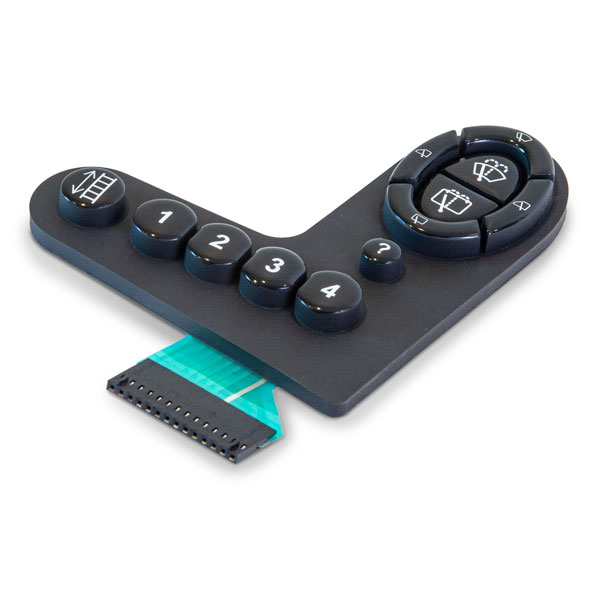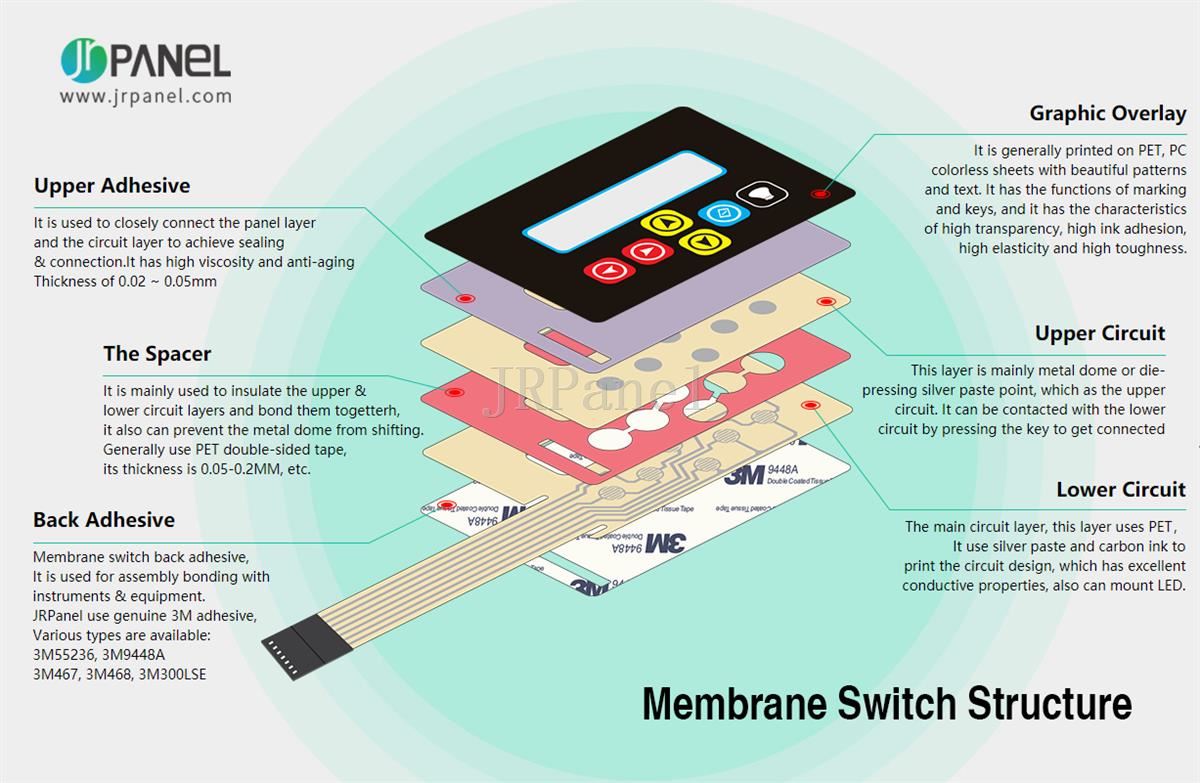Recognizing the Relevance of Membrane Layer Switch in Modern Electronic Devices
Membrane buttons are essential components in modern digital tools. They use a blend of capability and layout that improves user communication. Their lightweight and resilient nature makes them appropriate for various applications. As industries advance, the need for customization and progressed attributes expands. Understanding exactly how membrane layer changes contribute to technology discloses their relevance fit the future of electronics. What lies ahead for this innovation?
The Fundamentals of Membrane Layer Change Modern Technology
Commonly neglected, membrane switch modern technology plays a necessary role in the contemporary electronics landscape. These devices, composed of several layers, function as interface for various electronic items, ranging from home devices to medical devices. A normal membrane switch includes a graphic overlay, a spacer layer, and a circuit layer, which are diligently constructed to develop a practical interface.When pressure is related to the overlay, the circuit layer is finished, allowing signals to be transmitted to the device. This technology is recognized for its versatility, enabling personalization in style, capability, and form to meet specific individual demands. Additionally, membrane layer buttons are slim and lightweight, making them appropriate for applications where room is a costs. Their longevity and resistance to environmental variables further improve their allure, ensuring they can hold up against severe conditions while keeping functionality. On the whole, membrane layer button innovation is important to developing reliable and straightforward digital gadgets

Secret Benefits of Membrane Layer Changes
Membrane switches over deal several key benefits that make them a favored choice in numerous electronic applications. Their design permits a small form aspect, allowing manufacturers to develop light-weight and sleek tools. Furthermore, membrane buttons are resistant to dirt, moisture, and chemicals, which enhances their resilience and longevity in requiring environments. The responsive feedback given by these switches can boost individual experience, making them easy and user-friendly to operate.Furthermore, membrane buttons can be customized with varied graphics and colors, permitting one-of-a-kind branding chances. The production process is generally affordable, particularly for high-volume manufacturing, as it decreases assembly time and simplifies layout. Ultimately, membrane changes call for minimal upkeep, adding to lower general functional costs. These advantages highlight their expanding appeal in modern electronics, where integrity and easy to use user interfaces are important.

Applications Throughout Different Industries
The versatility of membrane layer switches over enables their prevalent adoption throughout different industries. In the clinical field, they are generally utilized in analysis devices and patient surveillance systems, providing a sturdy interface immune to pollutants. The automotive market utilizes membrane buttons for dashboard controls, improving user experience with streamlined layouts that endure extreme conditions. In consumer electronic devices, they function as control panels for tools such as microwaves and coffee makers, supplying an user-friendly interface that is very easy to clean. The aerospace industry utilizes membrane layer switches in cockpit controls, where integrity and room efficiency are vital. In addition, the industrial industry leverages these buttons in equipment and control systems to guarantee robust operation sought after settings. This wide range of applications highlights the versatility of membrane layer buttons, making them integral components in boosting functionality and individual communication throughout varied technical landscapes.
Modification and Design Flexibility

Future Fads in Membrane Layer Switch Over Advancement
Arising patterns in membrane switch development show an expanding focus on improved performance and integration with smart technologies. As customer need for a lot more advanced electronic devices rises, suppliers are concentrating on producing membrane switches over that not just serve basic functional duties however also incorporate attributes like touch level of sensitivity, backlighting, and haptic feedback.Furthermore, improvements in materials are expected to boost toughness and environmental resistance, making membrane layer changes appropriate for diverse applications in sectors such as health care, automobile, and customer electronic devices. The integration of capacitive touch technology is most likely to become extra common, enabling sleeker layouts and enhanced user interfaces. membrane switch.Additionally, the increase of the Internet of Points (IoT) is prompting the growth of membrane switches over that can interact wirelessly with various other gadgets, enhancing interconnectivity. In general, the future of membrane layer switch innovation appears encouraging, driven by innovation and the search of easy to use solutions
Often Asked Questions
Exactly How Do Membrane Changes Contrast to Conventional Mechanical Buttons?
Membrane switches, being a lot more space-efficient and offering a smooth style, comparison with conventional mechanical buttons that provide responsive responses. The former commonly feature adjustable graphics, while the last typically ensure longevity and dependability in different applications.
What Products Are Commonly Utilized in Membrane Layer Switch Over Production?
Membrane switches are normally produced using materials such as polyester, polycarbonate, and published conductive inks. These products give responsiveness, sturdiness, and adaptability, making them suitable for various applications internet in electronic devices and interface.
Can Membrane Switches Be Repaired or Recycled?
Membrane layer switches can typically be repaired, particularly if minor concerns emerge, such as adhesive failing or surface damage. Nonetheless, full reuse is commonly restricted because of use and potential destruction of products in time.
Just How Do Environmental Factors Influence Membrane Switch Over Efficiency?
Environmental variables, such as moisture, temperature, and direct exposure to chemicals, significantly affect membrane button performance. Severe conditions can cause degradation, impacting responsiveness and longevity, eventually compromising the performance of the device in different applications.
What Is the Regular Life Expectancy of a Membrane Layer Switch?
The normal lifespan of a membrane button generally ranges from 1 to 5 million actuations, depending on variables such as use regularity, ecological problems, and the products made use of in manufacturing, influencing toughness and performance durability. A common membrane button my response is composed of a graphic overlay, a spacer layer, and a circuit layer, which are meticulously set up to develop a functional interface - membrane switch.When pressure is used to the overlay, the circuit layer is finished, permitting signals to be transmitted to the gadget. The responsive responses given by these switches can enhance individual experience, making them easy and intuitive to operate.Furthermore, membrane switches can be personalized with varied graphics and shades, permitting for one-of-a-kind branding opportunities. As consumer demand for much more advanced digital gadgets increases, manufacturers are focusing on creating membrane switches that not only serve basic operational duties however also integrate features like touch level of sensitivity, backlighting, and haptic feedback.Furthermore, improvements in products are anticipated to boost resilience and environmental resistance, making membrane switches ideal for varied description applications in sectors such as medical care, auto, and customer electronics. The integration of capacitive touch technology is likely to come to be extra widespread, enabling for sleeker designs and improved customer interfaces.Additionally, the increase of the Web of Things (IoT) is motivating the growth of membrane switches that can connect wirelessly with various other gadgets, enhancing interconnectivity. Membrane layer switches, being more space-efficient and offering a streamlined style, contrast with typical mechanical switches that provide responsive comments